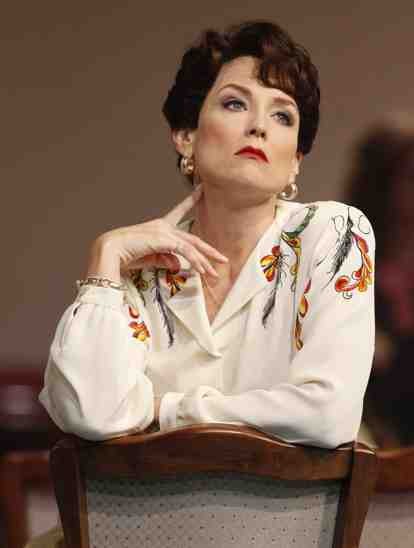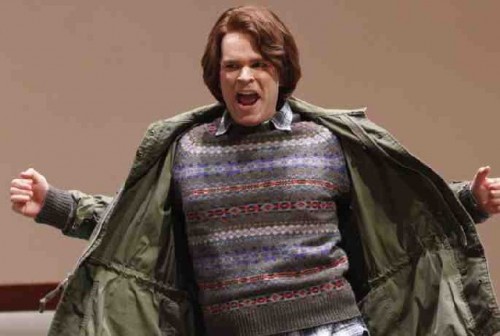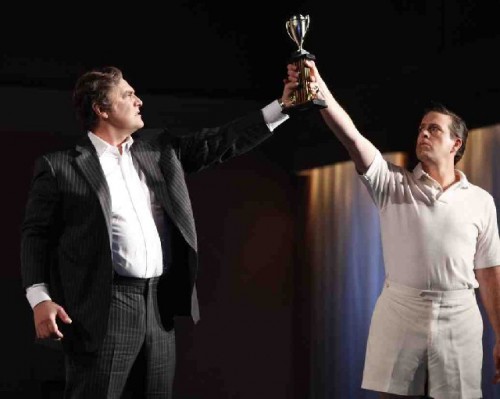Leonard Bernstein: New York City Opera
A Not So Quiet Place
By: Susan Hall - Nov 02, 2010
A Quiet Place
Leonard Bernstein/Stephen Wadsworth
New York City Opera
October 30, 2010, through November 21
Conductor Jayce Ogren
Production Christopher Alden
Set Designer Andrew Lieberman
Costume Designer Kaye Voyce
Lighting Designer Aaron Black
Cast (in order of appearance)
Funeral Director William Ferguson
Bill Michael Zegarski
Susie Judith Christin
Analyst Jonathan Green
Doc Jake Gardner
Mrs. Doc Victoria Livengood
Dede Sara Jakubiak
Francois Dominic Armstrong
Junior Joshua Hopkins
Sam Louis Otey
Young Sam Christopher Feigum
Dinah Patricia Risley
Miss Brown Mary Ragan
Young Junior Adam Burby
Photo credit: Carol Rosegg, courtesy New York City Opera
Christopher Alden directed this new production of A Quiet Place, last staged at Lowell House, Harvard. He has reflected the exuberance of Bernstein’s music on the stage. Action depicts the intense themes bound at base in love. Jayce Ogren, making his City Opera debut, captured all the musical styles deployed by the composer into a performance that both seared and delighted. Sets are simple, but effective, in part because they leave the emotional drama front and foremost.
Leonard Bernstein wanted to be taken seriously as a composer. He promised to conduct the Vienna State Opera in exchange for a performance of A Quiet Place. Far ahead of its time, some of the opera’s characters at first repulsed critics. Many could not look beyond a dysfunctional family to the score.
The music, which ranges from 12 tone to dance hall tunes, reflects the moods and personalities of the characters. Bernstein has remarkably synced the staged story with the musical tone of the piece.
We get to know many dysfunctional families in opera, but they are distanced by time, by royal class and by myth. In this opera, we have a typical suburban American family right in our face. We have gotten accustomed to seeing marital discord, addicted children, and homosexuality in novels and films like The Ice Storm and Far From Heaven. These themes will never be comfortable, but they longer shock.
Although Bernstein is said to have disliked his brother Burton’s memoir, each and every scene on the stage is told in this book. There is no question about the origins of A Quiet Place. The autobiographical themes and stories are wrenching.
Bernstein had a notion with which we still struggle: For the modern world, music must be presented in new forms. The Chinese wall that once separated Broadway and pop from the City Opera must come down. In presenting A Quiet Place, City Opera continues its exciting and entertaining effort to do this. Honoring Bernstein is not the only purpose George Steel, the City Opera’s brave and effective General Manager and Artistic Director, achieved in this mounting.
“Grief is music,” we hear at the start. Everyone in this piece is grieving because they can’t reach across seemingly insurmountable boundaries which divide their intimate being from the expectation of others in the family.
Iconic images combine set and action: Junior standing on the frame of a sofa, arms and legs spread wide looks like the crucifixion. Dede is poised high above the garden swing, but she can’t fly. The garden prompts the opera’s most beautiful aria, the mother’s dream of a quiet place to be together.
Stage left for much of the second act Junior is one with a piano, caressing it, making it his. When the Bernsteins received their first piano, a gift from Aunt Clara who was on her way to a state asylum, the young Lenny immediately took up the instrument. We do not see the years of battle that ensued as Lenny begged for lessons and his father Sam at first refused and then acceded to one-dollar, three-dollar and finally six-dollar instruction.
Although the Bernstein family were active Jews, this opera is non-denominational, and the garden aria could well fit in after "How Lovely is Thy Dwelling Place" in the Brahms Requiem. The first act takes place in a funeral parlour at an event following the death of the mother. At the end of the act, performers back out of the room, subtly suggesting that we are going to go back in time. This production is full of touches which add pleasure, but you can also simply sit back listen to the gorgeous singing evoking the funny and tragic moods.
Patricia Risley sang Dinah, the mother, with particular effect. Hers is the garden aria, produced in a lush and clear voice. She could turn on a dime to vamp in "What A Movie", in which she parodies a fun but stupid movie, Trouble in Tahiti, she’s just seen with friends. Trouble in Tahiti is the title of a one act opera by Bernstein that has been folded in as a second act in A Quiet Place.
The other super star of the evening was Joshua Hopkins, as Junior. His last act aria brought the house down. His light baritone, full of colour, made a difficult role sympathetic. In the final moments, he kneels before his father in an embrace, much like the prodigal son.
Sara Jakubiak was remarkable in her frenetic, over-the-top negotiation of her husband and her brother, who fulfil their personal preferences through her. Her poignant acceptance of her position in the sandwich was wrenching.
Sam, the father, past and present, is sung by Louis Otey in a large baritone and Christopher Feigum, in the lighter role of young Sam. The cast to a one were excellent. In smaller roles as Susie and Mrs. Doc, Judith Cristin and Victoria LIvengood were delightful and funny.
Bernstein’s outing did not make him a less productive artist, as was surely the case with E.M. Forster. I was taken aback as I listened with pleasure and great interest as the variegated music revealed each character's mood. It is a wonderful, riveting opera that deserves great success. As Bernstein’s own father Sam used to say, “Keep a finger crossed.”
boxoffice@ccmd.org and 212-870-5570
www.nycopera.com




